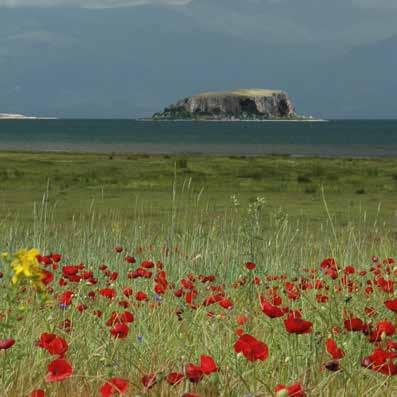
8 minute read
Highlights 2019
Highlights in 2019
What did we achieve together in 2019 in terms of the protection of Europe‘s rivers, forests, migratory birds and large carnivores? Actors who are part of the EuroNatur network present their personal highlights.
Advertisement
„In response to pressure exerted by BPSSS, a special police unit
for ‘green crimes’ was established in Serbia – a total novelty in our country. We closely cooperate with the officers. They
have understood that we are able to help the government to effectively combat bird crime. Milan Ružić, founder and President of BPSSS, EuroNatur partner in Serbia. “ „ Illegal logging of the Carpathian forests is one of Europe’s biggest
environmental crises. In 2019, together with Agent Green and ClientEarth we have taken our fight for this natural forest treasure to the next level by submitting a complaint against the
Romanian authorities to the European Commission. Now we have a real chance to save Europe’s last primary and old-growth forests. Gabriel Schwaderer, EuroNatur’s Executive Director. “
„We are proud to have accepted the 2019 EuroNatur Award on behalf of all the other women from Kruš čica. In our fight for our beloved river we really have all made a lot of sacrifices. We hope that we, the women of Kruš čica, encourage many other women and indeed entire societies to stand up against oppression. Medina Zukan, Maida Bilal and Safija Ahmić (left to right), inhabitants of Kruščica, Bosnia-Herzegovina. “

„Kostas, Lena and Nicole, the orphaned Mediterranean monk
seals, took our hearts by storm. But even from an entirely objective point of view their rescue was a major success.
Given that a population of just 350 individuals remain in
the Mediterranean, each single rescue contributes to the re-establishment of these rare monk seals. Magdalena Kulisch, project manager at EuroNatur. “ „ With the help of EuroNatur donations we were able to file
charges against the ‘bear killer gang’ from Palencia, and
Fapas was able to cover the legal fees for the lengthy court proceedings. This was an important success for the protection of bears. This case is likely to encourage rangers and the
police to track and file charges against other groups of illegal hunters. Roberto Hartasánchez, President of Fapas, EuroNatur partner in Spain. “
The inclusion of Munella Mountains, one of the few places where Balkan lynx are known to still reproduce, in the candidate list of protected areas in Albania is a major step in the right direction. A 530 km 2 refuge will help the survival
of these endangered felines and many other threatened species such as bears, chamois and golden eagles. Aleksandër Trajçe, Administrative Director of PPNEA, EuroNatur partner in Albania. “
European Green Belt
Nature conservation along what used to be a chasm between systems
Geographical location in Europe Ecosystem network with an extraordinarily high level of biodiversity, forming a 12,500 km long corridor along the route of the former Iron Curtain (Map p. 7). The European Green Belt connects eight biogeographical regions and 24 nations.
Status In the shadow of the Iron Curtain a unique habitat network was able to develop with an astonishing level of species diversity. It offers space for European large mammals as well as for a myriad of endangered invertebrates and plant species. But pressure on the Green Belt is intensifying, with habitat destruction, illegal hunting and non-sustainable tourism being on the increase.
Objectives Our aim is to foster sustainable regional development along the Green Belt that allows for the conservation of the interconnected habitats as an ecological network while ensuring local peoples’ livelihoods. Moreover, we endeavour to establish the European Green Belt as a symbol of peace as part of the European culture of remembrance.

During the Cold War period, a corridor of walls, barbedwire fences and anti-personnel mines divided our continent. But the Iron Curtain has transformed into a literal lifeline and now forms Europe‘s green backbone.
When it comes to nature conservation, EuroNatur thinks beyond borders. The European Green Belt initiative is an excellent example of how that kind of thinking is put into practice. At the institutional level, EuroNatur chairs the European Green Belt Association e.V. (EGBA) and is the regional coordinator of the Balkan Green Belt section. Together with our Balkan partners we work on tangible solutions for the reconciliation of people and nature along the Green Belt, for example by means of organic grazed livestock systems. The transboundary cooperation on the European Green Belt contributes to international understanding.

Selected activities in 2019 The length of the European Green Belt is historically determined. But how wide is the ecological network? In 2019, the EGBA stakeholders agreed on the criteria used to calculate the extent of the Green Belt. The result: Including its marine areas (but excluding the Fennoscandian segment) the ecological network covers an area of more than 275,000 km², 36 per cent of which have already been given a protective designation.
Once again, the European Green Belt Days were held with a view to strengthening the awareness and popularity of the European Green Belt. Together with local partners, EuroNatur organized several highly visible activities along the Balkan Green Belt, including a number of transboundary field trips, for example on Lake Kerkini (Map p. 7, No. 10), on the Greek-Bulgarian border which is known for its highly diverse birdlife.
Selected achievements in 2019 The year 2019 marked the 30th anniversary of the fall of the Iron Curtain. A central festive event at the occasion of the anniversary was held in the Austrian town of Illmitz. The event culminated in the signing of the ‘Illmitz Resolution’. With this Austria incorporates key requests set out in the ‘Eisenach Resolution‘ and commits to maintaining the Green Belt as a unique natural landscape unit. In this context, important major media outlets from all across Europe reported on this European conservation initiative.

Outlook We endeavour to more intensively promote the initiative vis-à-vis the EU Commission as a model for green infrastructure in Europe. The European Green Belt Days are again to be held in 2020 with a view to raising the initiative’s profile.
Partners: All EGBA members and stakeholders in the European Green Belt initiative.
Funding: EuroNatur’s donors and sponsors
European Green Belt
„ Nature brings us together Interview with Daniela Zaec “
Daniela Zaec from North Macedonia loves Lake Prespa (Map p. 7, No. 9), her place of birth, one of the southernmost jewels of the European Green Belt. After many years in the capital Skopje, the nature conservationist has returned to her home region to work for our partner organisation, the Macedonian Ecological Society (MES) – right on the border with Albania and Greece.
What is it that you love so much about the Prespa region?
In addition to many great childhood memories, above all it is the region’s rugged beauty. That’s the unique attraction of the Prespa region. Ezerani, for example, is a wetland area on the northern shore of Lake Prespa and a paradise for birds. It’s so wild there and there’s so much to see.
Do you worry that the wild beauty of Prespa could be lost?
Yes, the biggest danger is that those of us who live in the Prespa region take this beauty for granted and that we fail to realise how much our behaviour is putting it at risk. People must be made aware of that. Nearly every day new apple plantations are springing up - in protected areas too. There’s a lot more pesticide use than necessary. All these harmful substances end up in the lake. And the extraction of sand on Lake Prespa’s shores is just as damaging. Many areas, that I remember from my childhood as places of wild beauty, have been obliterated by summer homes or have simply become apple plantations.


Why is international support so important in ensuring Prespa remains a good place to live?
We don’t receive government funding, so we have to figure out ourselves how to finance our nature conservation activities. Right from the very beginning, EuroNatur has recognised the value of the Prespa region right from the outset and has always been ready to help us, both technically and financially. What I appreciate most is that you actually come to see us, talk to us and listen to us. You don’t say: ‘Here’s our plan, now put it into practice’, but instead you see our vision and help us to realise it. That doesn’t happen very often.

How important is cross-border cooperation with Albania and Greece?
Very important! We knew that if we really want to achieve something, we have to work across national borders and we need joint goals. That’s a major step forward because, for a long time, there was no international contact between conservationists from the three countries, mainly because of the political situation. Today, together with our colleagues in Greece and Albania we are developing nature conservation objectives, helping each other and sharing our knowledge. With each of our activities we are trying to bring the people of the three nations together. There is so much that connects us; we share the lake, the mountains and we live close to each other. Nature brings us together.
Interview: Katharina Grund







